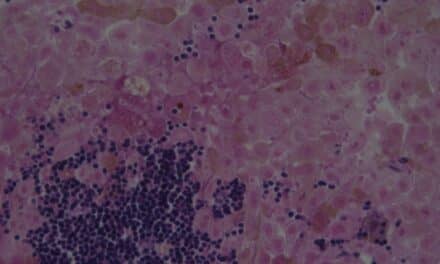Summary: The test uses gene expression profiling to provide personalized risk assessments, reducing unnecessary sentinel lymph node biopsies (SLNB) and lowering healthcare costs in melanoma patients.
Takeaways:
- Personalized Risk Prediction: DecisionDx-Melanoma analyzes the activity of 31 genes to predict a patient’s risk of sentinel lymph node positivity, helping clinicians avoid unnecessary SLNBs.
- Clinical Impact: Studies show that this test has reduced unnecessary SLNBs by nearly 30% in low-risk patients, improving patient management and reducing morbidity.
- Cost Reduction: By minimizing unnecessary procedures, the test can save healthcare systems significant costs, with projections showing potential savings of over $3 million per 1 million plan members over five years.
A new gene expression test offers personalized risk assessments to reduce unnecessary sentinel lymph node biopsies, improving melanoma care and cutting healthcare costs.
By Andy Lundin
A new gene expression profile (GEP) test from Castle Biosciences, DecisionDx-Melanoma, is shifting the cancer diagnostic paradigm by providing more personalized, biologically driven risk assessments that help clinicians better decide who should undergo sentinel lymph node biopsy (SLNB).
SLNB has long been a critical tool for determining whether cancer has spread to nearby lymph nodes. While effective, this invasive surgical procedure comes with its own risks and costs.
Clinicians have traditionally relied on tumor staging guidelines to determine which patients should undergo SLNB, but these guidelines may result in unnecessary surgeries that increase patient morbidity and healthcare expenses.
“We are performing SLNBs in patients who may not need the surgery, unnecessarily increasing patient morbidity and healthcare costs,” says Joseph Bennett, MD, a surgical oncologist and system chief of surgery at LifeBridge Health in Baltimore, Maryland. “DecisionDx-Melanoma provides critical information not captured by clinical and pathological features alone. It allows for a more personalized risk prediction and enables clinicians to make more risk-appropriate management decisions.”
The Limitations of Traditional SLNB Guidelines
Under current National Comprehensive Cancer Network (NCCN) guidelines, decisions regarding SLNB are largely based on a patient’s tumor stage. For example, patients with tumors classified as T1a, which are thinner and less aggressive, are typically not recommended for SLNB unless additional high-risk factors are present. In contrast, patients with T1b to T4 tumors are more likely to be offered the procedure due to the higher assumed risk of sentinel lymph node (SLN) positivity.
However, data suggests that only around 12% of patients undergoing SLNB actually have a positive SLN, meaning that the majority of patients could be undergoing this invasive procedure unnecessarily.
How DecisionDx-Melanoma Works
The DecisionDx-Melanoma GEP test analyzes the activity of 31 genes within the primary melanoma tumor. This test provides a score and a class result that stratifies patients into three risk categories:
- Class 1A (low risk)
- Class 1B/2A (moderate risk)
- Class 2B (high risk).
By integrating this molecular data with clinical and pathological factors, DecisionDx-Melanoma offers a more precise prediction of SLN positivity, allowing clinicians to make more informed decisions.
A recent study1 demonstrated that 85% of SLNB decisions were influenced by the results of DecisionDx-Melanoma, reducing unnecessary SLNBs by nearly 30% in patients with the lowest risk result.
“The test helps us identify patients traditionally thought to be at higher risk but who biologically have a lower risk of SLN positivity,” Bennett says. “This allows us to guide these patients toward alternative management options.”
Additional Validation of Accuracy
Further validation of the DecisionDx-Melanoma test came from an additional study2,which involved 156 melanoma patients who underwent SLNB. The study found that using DecisionDx-Melanoma could have reduced the number of unnecessary biopsies by almost 20%, with a reduction rate of 33% in patients with T1–T2 tumors. Importantly, no positive SLNs were missed in patients categorized as low risk by the test.
Reducing Costs and Complications
The benefits of DecisionDx-Melanoma extend beyond clinical outcomes. By reducing unnecessary SLNBs, the test also has the potential to significantly reduce healthcare costs, Bennett noted.
A model presented at the 20th European Association of Dermato-Oncology (EADO) Congress estimated that using DecisionDx-Melanoma could save commercial payers over $3 million per 1 million plan members over five years. Additionally, SLNB is associated with a 5% complication rate, which could lead to increased healthcare costs for follow-up treatments such as seroma drainage or antibiotic prescriptions.
Andy Lundin is CLP’s associate editor.
Further reading: Castle Biosciences’ Melanoma Test Influences Patient Care Decisions
References
- The 31-gene expression profile test informs sentinel lymph node biopsy decisions in patients with cutaneous melanoma: results of a prospective, multicenter study Yamamoto M;Sickle-Santanello B;Beard T;Essner R;Martin B;Bailey CN;Guenther JM; https://pubmed.ncbi.nlm.nih.gov/36617959/
- Integrating the melanoma 31-gene expression profile test with clinical and pathologic features can provide personalized precision estimates for sentinel lymph node positivity: an independent performance cohort Kriza C; Martin B; Bailey CN; Bennett J; https://pubmed.ncbi.nlm.nih.gov/39215342/




